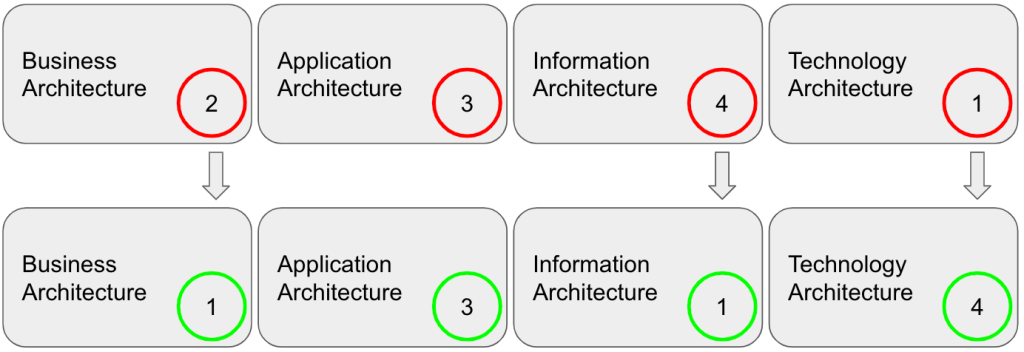As someone who’s practiced professionally as both a data and enterprise architect, I’ve always felt that EA practices had too much focus on technology. If you’ve worked in the EA field, it should come as no surprise that the majority of Enterprise Architects have come to their role from previous technical roles within IT. While it’s rare that an EA has a business background, it certainly happens . Each path has its strength and weakness.
For those with the tech track in their background, many must overcome an inherent bias towards tools and technology. One key change facing many people, regardless of role, is the mind shift in enterprise architecture as it relates to prioritization. As data becomes the new medium, so must EA shift to accommodate reforming the classic Enterprise Architecture BAIT model (see Figure 1).

Figure 1: The 4 pillars of traditional Enterprise Architecture
The four pillars self describe their functional aspect of an enterprise. The Open Group has built a solid foundational framework on this model for their TOGAF standard. This ‘traditional’ EA process charts a course to define clarity across each of the pillars thru TOGAF’s ADM, as depicted in Figure 2. This approach seldom achieves the required balance across the domains, however. The reason lies in the bias for tools that most of the workforce holds, in addition to the level of discipline and work required to map the pillar relationships to requirements.

Figure 2: Aspirational synergy across the enterprise architecture landscape
While frameworks abound, It should be clear to anyone not living under a rock that this is a software driven world. To that end, capability discussions almost always start with a tool in mind. So Technology leads. This isn’t always a bad thing. A consequence, when it comes to data and process, is that applications and tech can hem in information and supporting workflows that, absent a deep understanding of the supporting technology, often become a barrier to unlocking critical data for the business. Still, tech is invariably always the starting point.
Speaking of the business, of course IT knows where its bread is buttered. While most CIOs command a significant budget, the lions share (often as much as 95%) is usually already spent on ‘keep the lights on’ support and operations. Any new technology or tooling usually requires that business functions outside of IT sell in the request and find the funding. So as it relates to the Business/IT relationship, business functions drive requests for information, apps and technology. Business process these days lives in applications and the way the workforce uses their application portfolio to drive the day to day operations of any business. It’s in these applications that process gets anchored, if not buried.
For may organizations, the CapEx and OpEx models define the lifecycle of these applications. Larger monolithic platforms such as ERPs and CRMs often require depreciation models to cover ever increasing costs for licensing and implementation. This often manifests as a 5-7 year lifecycle for an app that should likely be replaced (or invested in) every 3 years.It’s also where data lives, much of the time in proprietary formats that are difficult to extract or catalog. Alternatively, software-as-a-service (SaaS) and platform-as-a-service (PaaS) apps often mask the data in raw form; something potentially challenging for master data governance and data quality efforts.

Lastly, and unfortunately, the containment of data and information, be it structured, semi-structured or unstructured usually falls to an operational position of back it up, secure it or report on it; at least when it comes to tech and app centric architectures. More companies spend more time and effort trying to locate that single source of trusted data. It’s here where stewardship efforts die a slow death as they fight access controls, general accessibility as well as complicated data transformation lineages and data ‘experts’. The end result is a practical application of the EA BAIT model as shown in Figure 3. Where data, for all intent and purpose slip to the lowest priority as it relates to the implementation of a company’s Enterprise Architecture .
It’s in this gap where the journey to Enterprise Stewardship begins. Architects must rethink architectural priorities. They must also lead the change to the IT and business mindset: Business and information architecture must operate at parity. The synergy between a business and its information — whether it be internal and externally sourced — must be seen as one. All supporting architectures must focus on this as a priority model. Of course applications will still be how mere mortals (i.e. business users) actually lead the conversation around what data to use, as well as how and when to use it. But the power has shifted from the once almighty database administrator into the hands of business leaders, data wranglers and functional leads. Enterprise leaders must accept the mantel as stewards of the data.
Let’s revisit the notion of applications and apps for a moment: We all of course get that apps are tech. That said, an overarching drive for transformation in technology has been the migration to the Cloud. Silicon Valley is obsessed with this, while regulators do an opposite dance. Many IT organizations are moving there in hybrid forms, if they are not already Cloud-based. In many cases, however, it is now CISO and RISK who are installing barriers to Cloud delivery. The complexity of securing and hardening a hybrid between on-premise and Cloud is anything but trivial. There are other barriers to SaaS as well. CFOs, for example may also be holding companies back as they struggle to rationalize legacy technology investments on the books. To be sure, technology has been commoditized. Gone should be the days of the $150 server and 7-year license depreciation.
While Cloud and SaaS platforms bring their own complexity and challenges, ultimately they are loosely coupled to the business and should only exist to drive business/information parity. It’s here where the king falls, as technology moves to the bottom of the priority stack. This shift will also present a significant change management issue.
In the end, the changes we are advocating will be required to support Enterprise Stewardship and are best represented in Figure 4. It’s only right that Business Architecture move to the forefront of EA’s world. Similarly, and more dramatically, will be the shift in focus for the Information pillar as it maps to parity with the Business Architecture pillar. As dramatic, is the reprioritization of Technology Architecture, as it moves into the commodity lane. But how to get there?

The focus here is how to drive the transformation from Enterprise Architecture to one of Enterprise Stewardship. We just need to recognize the role that business capability models and application portfolio management play in the transformation journey.

